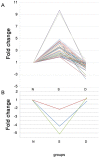Application of D-Crustacean Hyperglycemic Hormone Induces Peptidases Transcription and Suppresses Glycolysis-Related Transcripts in the Hepatopancreas of the Crayfish Pontastacus leptodactylus - Results of a Transcriptomic Study
- PMID: 23840318
- PMCID: PMC3686806
- DOI: 10.1371/journal.pone.0065176
Application of D-Crustacean Hyperglycemic Hormone Induces Peptidases Transcription and Suppresses Glycolysis-Related Transcripts in the Hepatopancreas of the Crayfish Pontastacus leptodactylus - Results of a Transcriptomic Study
Abstract
The crustacean Hyperglycemic Hormone (cHH) is a neuropeptide present in many decapods. Two different chiral isomers are simultaneously present in Astacid crayfish and their specific biological functions are still poorly understood. The present study is aimed at better understanding the potentially different effect of each of the isomers on the hepatopancreatic gene expression profile in the crayfish Pontastacus leptodactylus, in the context of short term hyperglycemia. Hence, two different chemically synthesized cHH enantiomers, containing either L- or D-Phe(3), were injected to the circulation of intermolt females following removal of their X organ-Sinus gland complex. The effects triggered by the injection of the two alternate isomers were detected after one hour through measurement of circulating glucose levels. Triggered changes of the transcriptome expression profile in the hepatopancreas were analyzed by RNA-seq. A whole transcriptome shotgun sequence assembly provided the assumedly complete transcriptome of P. leptodactylus hepatopancreas, followed by RNA-seq analysis of changes in the expression level of many genes caused by the application of each of the hormone isomers. Circulating glucose levels were much higher in response to the D-isoform than to the L-isoform injection, one hour from injection. Similarly, the RNA-seq analysis confirmed a stronger effect on gene expression following the administration of D-cHH, while just limited alterations were caused by the L-isomer. These findings demonstrated a more prominent short term effect of the D-cHH on the transcription profile and shed light on the effect of the D-isomer on specific functional gene groups. Another contribution of the study is the construction of a de novo assembly of the hepatopancreas transcriptome, consisting of 39,935 contigs, that dramatically increases the molecular information available for this species and for crustaceans in general, providing an efficient tool for studying gene expression patterns in this organ.
Conflict of interest statement
Figures


References
-
- Balik I, Çubuk H, Özkök R, Uysal R (2005) Some biological characteristics of crayfish (Astacus leptodactylus, Eschscholtz, 1823) in Lake Eǧirdir. Turkish Journal of Zoology 29: 295–300.
-
- Hubenova TA, Vasileva PL, Zaikov AN (2009) Histological analysis of ovary development in narrow-clawed crayfish Astacus leptodactylus Esch. 1823 (crustaceae, decapoda, astacidae), reared in ponds in South Bulgaria. AACL Bioflux 2: 261–270.
-
- Van Herp F, Bellon-Humbert C (1978) Setal development and molt prediction in the larvae and adults of the crayfish, Astacus leptodactylus (Nordmann, 1842). Aquaculture 14: 289–301.
-
- Hopkins PM (2012) The eyes have it: A brief history of crustacean neuroendocrinology. General and Comparative Endocrinology 175: 357–366. - PubMed
-
- Fanjul-Moles ML (2006) Biochemical and functional aspects of crustacean hyperglycemic hormone in decapod crustaceans: Review and update. Comparative Biochemistry and Physiology - C Toxicology and Pharmacology 142: 390–400. - PubMed
Publication types
MeSH terms
Substances
LinkOut - more resources
Full Text Sources
Other Literature Sources
Molecular Biology Databases

